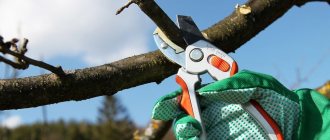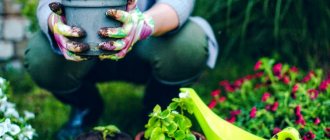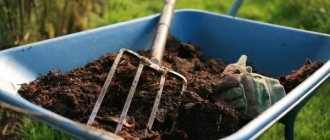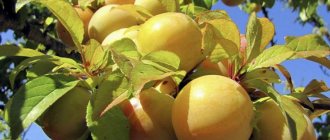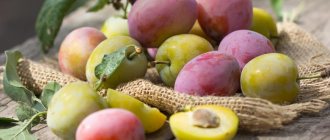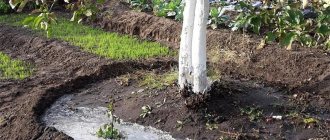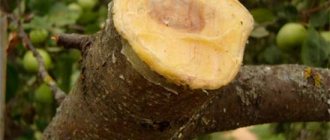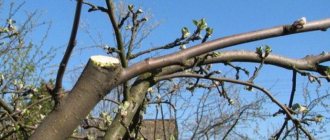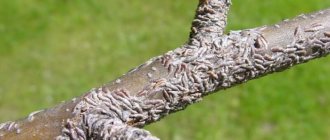Why do you need to whitewash trees in the garden?
It is known that tree bark is something like a protective jacket from adverse external environmental influences. Like, for example, human skin. The thinner and more delicate it is, the more sensitive it is to adverse factors. The same is true for vegetation in the garden.
In the garden, as a rule, fruit trees grow at a certain distance from each other, and they do not have the same protection as in the forest. In addition, besides sun rays, there are other reasons, to eliminate which they are whitewashed.
So, why can you protect trees by whitening their trunks?
- Protection from direct sunlight. The dark color of the bark heats up unevenly. The one on the south or west side heats up more than the one on the north. Differences in night and day temperatures also affect the fact that the temperature difference causes cracks (wounds) to appear on the bark. White color reflects direct sunlight. Therefore, there will be no uneven overheating of the bark, and it will not crack.
- Through cracks, various pathogens (fungi, bacteria) easily enter the wood, which causes the development of various diseases.
- Cracks in the bark are entry points for various insect pests to enter the wood. And rodent pests don’t mind eating young bark in winter either.
It is worth immediately noting that not all trees need this procedure. It is worth taking the most care of young specimens, since their bark is thin and more vulnerable. But older apple and pear trees already have a fairly thick layer of bark that no pests or diseases can handle.
Is whitewashing of trunks necessary?
Whitewashing the trunks is definitely necessary. The dark trunk attracts the sun's rays - as a result, burns are formed, and the white color has the ability to reflect ultraviolet radiation. A dangerous situation occurs in winter, around January. When, as daylight increases, bright rays heat the bark, causing premature sap flow. And at night there is no sun, and the temperature drops sharply. The liquid crystallizes, leading to tissue ruptures.
Often a similar situation occurs in the spring. When during the daytime the air warms up to +10–15°C, and at night the temperature drops below 0°C. Such sudden changes lead to a violation of the integrity of the outer cover of the tree. In autumn, whitewashing is especially recommended for warm regions where tree trunks are not insulated for the winter.
In the summer, such a process leads to overheating of the fruit tree trunk and excessive sap flow during fruit ripening. It is autumn whitewashing that protects apple trees from the negative effects of the sun.
Treatment of the outer cover of a tree allows you to get rid of a huge number of microorganisms, insect pests, and pathogenic fungi that have chosen the bark. A tree whitened in autumn will not be eaten by rodents.
When to whitewash trees in the garden - timing
Whitewashing of trees in the garden is carried out by gardeners in the spring or autumn. Autumn is the main one, as it is winter protection
- from rodents and ice formation;
- will not allow insect pests to hide for the winter;
- will not allow the bark to crack due to temperature changes.
In terms of timing, it is better to do this in late autumn before the onset of frost, that is, in October-November, depending on the region.
Spring whitewashing will be useful and will protect against changes in night and day temperatures, when in the spring the sun begins to warm up strongly, and at night there are still recurrent frosts. In addition, spring rains wash away the whitewash from the trees, so it needs to be renewed.
Whitewashing in the spring is carried out with the onset of the first warm days. In the southern regions it is February, in the more northern regions it is in April. If for some reason you did not whitewash them in the fall, whitewash them already in March.
However, it is important to remember that it must be done before the buds begin to bloom.
Another important point is the air temperature when you need to whitewash trees. The daytime temperature when whitewashing can be carried out should be within +5ºС.
Why whitewash trees
The bark is the protective shell of the plant, which absorbs all unfavorable changes in the external environment - temperature fluctuations, too bright sun, sharp cold wind, frost, pest invasion, rodent teeth and other phenomena. From such a load, over time it becomes rougher, cracks and peels off. Compare the smooth skin of a young tree and the cracked, rough surface of an adult or old tree. It is precisely because the plant bark receives the blow first that it is necessary to monitor its health.
Whitewashing of trees is a procedure aimed at effectively protecting tree bark:
- from winter and spring burns, when the lack of foliage makes the trunk and branches vulnerable to sunlight;
- from temperature changes leading to cracking of the bark;
- from frost damage;
- from insect pests that settle in the bark of trees.
In the photo: Preparation of a solution for whitening trees
Therefore, whitewashing tree trunks and skeletal branches must be done responsibly. Moreover, both fruit and ornamental trees should be whitened.
- Covering material: types, features, application
Preparation for whitewashing trees
There are certain rules that will allow you to do this procedure correctly and will not allow you to harm either the vegetation or the person himself.
- Whitewashing is carried out only in dry weather.
- Various compounds are used for processing; we will talk about them later. But more often, gardeners have recently been using a special water-based paint, which is sold in gardening stores. It stays on trunks and skeletal branches throughout the year, unlike lime.
- If you don’t have such paint on hand, you can use ordinary lime with the addition of copper sulfate.
- It is very important to coat with paint or composition not only the base of the skeletal branches and the trunk itself, but also the forks between the branches. This is where moisture accumulates and in winter frost holes can form here. Sunburns may form on the south and west sides, which turn into wounds and fruit canker on the bark.
- The prepared mixture for whitewashing should be homogeneous, without lumps, and the consistency should be similar to sour cream.
There is no need to whiten the stems of young seedlings, as this can lead to clogging of the pores on the thin bark. To protect the plant from temperature changes and pests, such trees must be wrapped in burlap or covering material.
In summer, you can protect the trunk from rodents with cut plastic bottles. To do this, the neck and bottom of the bottles are cut off and a vertical cut is made. Then such a bottle is put on the trunk and tied with twine so that it does not fly off.
When to whitewash trees
When to whiten trees in the fall
Professionals insist that whitewashing should be done twice, or even three times a year - in early spring, summer and autumn. The main whitewashing is considered to be autumn. It is carried out in October-November, just before frost. Whitewashing trees in the fall is done in order to protect them from fungi and pests that have settled in the bark for the winter. In addition, whitewashing garden trees, like ornamental ones, protects their trunks from the formation of ice, and hungry hares will not gnaw off the bark covered with lime.
When to whiten trees in spring
But if you were unable to whitewash the trees before winter, you will have to do it in February - at this time during the day the trunks without whitewashing heat up to 11 ºC, and this temperature is enough for sap flow to begin in the trees. Night temperatures at this time drop to -10 ºC, and the sap that began to move during the day freezes. As a result, tree tissue may rupture and frost holes may form - long and deep cracks in the bark.
The white coating on the trunks and bases of skeletal branches, repelling the sun's rays, does not allow the bark of trees to heat up to the temperature at which they begin to awaken, therefore night frosts are not so terrible for trees.
In the photo: Whitewashing trees in the garden
If the autumn whitewashing was carried out on time, in the spring - in February or March, or even in early April - it needs to be refreshed.
Do you need to whitewash trees in summer? If the whitewash layer was washed away by heavy rains in spring and summer, then it is better to restore it, but if the trunks are covered with a persistent, indelible composition, then there is no need for summer whitewashing.
Autumn pruning is another stage of preparation for wintering
Autumn, spring and summer whitewashing is carried out only in dry weather.
- Eschscholzia: growing from seeds, planting and care
How to whitewash trees correctly
Whitewashing trees is a responsible job and therefore it is important to properly prepare for it first.
Since you will be working with aggressive materials, prepare in advance for your protection:
- gloves, preferably thick rubber ones;
- respirator or face mask;
- Oilcloth or tarpaulin, which you will need to place under the tree;
- Sponges or brushes for washing off dust and dirt from the bark. It is not recommended to use metal brushes, as they can mechanically damage the bark.
Then proceed as follows.
- Spread a tarpaulin or oilcloth under the tree.
- Using a brush with nylon bristles, remove the trunk and skeletal branches from dirt and dust. Don't forget to clean the recesses in the forks of the branches; this can be done using a peg.
- Burn any debris that falls on oilcloth or tarpaulin; it may contain pest larvae and pathogenic microorganisms.
- Whitewashing is carried out to a height of 1.5-2 meters, that is, up to the first branches. And be sure to whiten the bark of adult large branches that are located at the bottom of the tree.
- The prepared mixture is poured into a container into which a brush or roller fits freely.
- The composition is applied in several stages so that a layer of 2-3 mm is formed. Moreover, the next layer is applied only after the previous one has dried. The layer should not be thicker, otherwise the paint will crack and fall off.
It is recommended to whiten fruit trees twice a year, this way you will protect the trees from pests and rodents.
How to whiten: processing old young apple trees
Lime solutions are intended for whitewashing; you can prepare one yourself. It is necessary to dilute quicklime in water. Or buy a ready-made mixture in a store or market.
May be interesting Features and rules for planting an apple tree in the fall in the Urals What to do if the apple tree does not shed its leaves for the winter How to properly graft an apple tree in the fall: timing and features of grafting
You can whiten apple trees in the fall using:
- The cheapest and most popular painting method is lime mortar. The disadvantage of this method is the low degree of protection. At least two rains are enough and not a trace will remain of the whitewash.
- Acrylic or water-based paint. It includes drugs that prevent the development of fungi. This method creates a protective film around the trunk, but does not allow the plant to breathe. Therefore, only mature, old trees are whitewashed with paint.
When choosing a painting material, you should pay attention to three components: the white coloring substance, the viscous component, and the disinfecting components.
Whitewashing is necessary for both adult apple trees and 1-2 year old seedlings. The concentration of the solution for a young plant will be 2 times less than for old trees. Typically, wood can be whitewashed from the age of 3 years. You only need to paint apple trees this way when the tree bark becomes smooth and plates and cracks appear, then you need to start whitewashing.
The brush should be selected taking into account the width of the wood, which will save time and whitewashing. For large mature trees, a spray gun is suitable, which can fill all the cracks and evenly cover the entire trunk. During painting, the applied layer should not exceed 3 mm, otherwise it will not allow the wood to breathe and will quickly fall off. The whole process consists of several stages:
- Preparation of working material. Purchase or make the solution yourself and let it sit for 2 hours.
- Stir well until smooth, eliminating lumps.
- Remove the top layer of soil around the apple tree to a depth of 5 cm.
- Whitewashing should begin at a height of 150-200 cm from the ground surface, gradually covering the trunk from all sides and going down.
- Skeletal branches are processed at a height of 25 cm before joining the trunk.
- The trunk should be whitened to the base, going 3 cm below ground level.
- The removed soil must be sprinkled back after the whitewash layer has dried.
Attention!
If the whitewash is not a bright gray color, then the procedure must be repeated so that the color becomes uniform and rich.
Treatment of trees before whitewashing
After completing the preparatory work, the bark must be disinfected. This must be done in order to destroy pathogens and pest larvae remaining on it. For this purpose, a solution of copper sulfate is used. To prepare it, take 150-200 g of copper sulfate per 5 liters of water.
Since this drug is quite toxic, it can be replaced with Bordeaux mixture, or HOM and Oxyx, or an ash-soap solution.
Bordeaux mixture . Spraying is carried out before flowering with a 3% solution. For a young tree use 2 liters, for a large one - 10 liters.
Soap-ash solution . Since copper is toxic to plants, it is advisable to alternate treatment with Bordeaux mixture with treatment with a soap-ash solution. To prepare it, add 1.5 kg of sifted ash and 25 g of grated laundry soap to 5 liters of water.
Fine spraying is carried out; for this, the sprayer is brought close to the trunk. This way the solution will remain on the bark.
After treating the bark, let it dry, and then all cracks and wounds must be covered with garden varnish or Rannet paste. These products are sold in gardening stores. Or you can make your own garden varnish. To do this, take:
- rosin – 1 part
- beeswax – 2 parts
- unsalted fat - 1 part
How to properly prepare your own garden varnish
- Melt the wax over low heat and then add rosin to it. When they are melted, mix them while they are still hot.
- Add fat to the liquid mixture and mix again until smooth.
- The warm mixture is poured into cold water, then taken out and rolled into a ball with your hands.
- Before use, the garden varnish prepared by yourself is slightly heated to make it more elastic, and the defects on the bark are covered with it.
Preparing clay mash
An alternative to garden pitcher can be a clay mash. To prepare it you will need:
- Purified clay – 2 parts
- Mullein – 1 part
- Some chopped straw
Prepare the mash immediately before use. To do this, all ingredients are mixed, diluted with water to a thick sour cream, and then used for their intended purpose.
How to whiten and how to prepare the solution?
What to whitewash and what substances are best used for whitewashing depends on the period in which whitewashing is done, as well as for what purpose: to prevent sunburn, or to protect the wood from various types of pests. Let's consider several options for preparing solutions at home.
The most popular whitewashing method involves the use of lime. This is the most profitable option for treating fruit trees, especially if there are a lot of them in the garden. To prepare the solution you will need:
- quicklime;
- clay, or casein or wood glue;
- water.
Suppress the lime with water, add 50% of the weight of the lime, clay, or glue for viscosity and prepare a solution with a consistency like sour cream. The solution should be very thick, since during processing it will cover the tree trunk with a thick layer, which will not be washed off as quickly as when whitewashing with liquid lime.
In order to protect your apple tree from sunlight and at the same time carry out treatment against various insect pests, you can use the following composition:
- fluff lime about three hundred grams;
- half a glass of milk , or liquid glue, which you can find in your home;
- two liters of water ;
- 5 grams of copper sulfate;
- 5 grams of powdered substance - DDT .
In cases where young seedlings are being processed, it is best to use chalk, since lime can slightly damage the young, not yet strong crust of the tree. Chalk is recommended to be used throughout all treatments during the first years of the apple tree’s life.
For autumn treatment of fruit crops, the following solution is used:
- 2 liters of water, or you can use chamomile infusions;
- 40 grams of copper sulfate, you can use iron sulfate, then the apple tree will receive an additional nutrient - iron, along with protection from insects;
- as a thickener you can use glue or clay in a ratio of 50% of the total amount of the contents;
- it is also necessary to add creolin and “Knockdown” in order to protect the apple tree from various rodents that are not averse to eating the bark of the apple tree.
Among other things, adult fruit trees can be treated with water-based paint or acrylic. Their color must be snow-white, and not with some gray shades.
When treating with such compounds, it is necessary to add antifungal drugs to the paint, which can create a protective film around the trunk of the fruit tree to prevent the occurrence of all kinds of tree diseases.
How to properly dilute lime and copper sulfate
When using Bordeaux mixture, it is important to know how to properly dilute lime and copper sulfate. Prepare 2 containers in advance, it is better to take plastic ones. Iron ones will not work because the metal will react with copper.
- Dilute copper sulfate in one container - pour 100 g (this is half a glass) into the container, add 1 liter of water and stir with a wooden stick. Then add the volume to 5 liters. It is better to use hot water for dilution, so the crystals will dissolve faster.
- Carefully pour the lime into another container. It is small, so it is better to carry out the work wearing a respirator or mask. Add a little water and stir until smooth. And only after that add water to a volume of 5 liters. Mix thoroughly so that no lumps remain.
- Next is a very important moment; both of these solutions must be combined. Pour the vitriol solution into the lime solution in a thin stream, stirring constantly with a stick. As a result, you will get a solution of a beautiful blue color.
It is important to remember and do not get confused: pour the vitriol solution into the lime solution, and not vice versa!
Whitewashing apple trees - when and how to whitewash?
The health and integrity of the bark ensures the longevity of the fruit tree and, accordingly, an annual healthy harvest.
If you do not protect and care for the bark of the apple tree, then frequent ruptures of stem tissues and peeling of large areas of bark can lead to premature death of the tree.
When to whiten apple trees?
Caring for the covering of a fruit tree involves properly whitewashing the tree trunk. Experienced gardeners recommend keeping their apple trees in a whitewashed state all year round. Whitewashing must be done at least three times:
- Autumn whitewashing is carried out from mid-October to early November.
- Repeated whitewashing is carried out with the onset of spring warmth at the end of March , beginning of April.
- Additionally, it is necessary to bleach the apple tree in the middle of summer , in particular after the rains have washed away the main layer of protection from the tree bark.
Why are apple trees whitened?
The answer to this question lies on the surface. The fact is that white color is capable of reflecting the sun's rays, and the color of the bark of apple trees is dark, so it attracts light rays, which leads to the formation of sunburn.
Sunburn occurs from the end of January, the intensity of their manifestation increases as daylight hours and sun activity increase.
Therefore, if the tree bark is not whitened, it will attract the sun’s rays, and as a result of heating the apple tree trunk in the daytime, sap flow begins to occur inside it.
In the evening, when the sun is no longer there, the temperature drops sharply, which leads to crystallization of the juice, and, accordingly, to ruptures of the stem tissues - this is called a sunburn.
Just like in summer, the dark color of the bark attracts the heat of the sun, which in turn leads to overheating of the fruit tree trunk, excessive sap flow during fruit ripening, and sunburn.
Compositions for whitewashing trees in the garden
It is important to understand that for whitewashing trees, compositions are used, each of which plays a specific role.
- A solution of lime or garden chalk is white; it is the white color that helps reflect the sun's rays. And this prevents further overheating of the bark.
- Fungicides or disinfectants can be added to the solutions, and this will protect the trees from bacterial and fungal microflora.
- Using clay or glue, the applied paint will not be washed off from the bark during rains and after the snow melts in the spring.
To prevent solutions from flowing off the bark, the consistency of the solutions should be like sour cream. So when you add water, pay attention to this.
Composition No. 1
- Dilute 1.5 kg of chalk or lime in 5 liters of water.
- Add 250 g of copper sulfate and 50 g of casein glue, or the same amount of flour paste. Mix thoroughly to obtain a homogeneous solution.
- Leave the solution to sit for 2-3 hours and the solution is ready for use.
Composition No. 2
Mix the following ingredients in 5 liters of water until smooth:
- Slaked lime – 1 kg
- Fatty clay – 0.5 kg
- Copper sulfate – 100 g
Let the mixture brew for 2-3 hours and use as directed.
Composition No. 3
- Dissolve lime and copper sulfate in 1 liter of hot water and stir well.
- After the solution turns blue and cools slightly, add 50 g of casein glue or flour paste.
- Bring the volume of the composition to 5 liters of warm water and mix.
The composition is ready for use.
Composition No. 4
Instead of glue, this composition uses manure. To prepare the mixture, dissolve 500 g of lime and 100 g of copper sulfate in 4 liters of warm water, then add 500 g of manure and mix everything thoroughly.
The finished mixture is left for 2-3 hours and then used to whitewash the trunks.
Dear readers, there is another alternative for protecting trees from sunburn. This method is described in the video. You may find this method more practical and economical. Take advantage of it too.
Dear friends, in this article I told you why and how to properly whitewash fruit trees in the garden. The recommended mixtures will require some time to prepare. However, you can buy ready-made ones for this in gardening stores. This will save a lot of time. But the choice is yours. However, such a procedure must be carried out every year.
Have a good harvest!
Typical mistakes when whitening apple trees
When whitewashing apple trees, some gardeners make common mistakes that significantly reduce the quality and protective functions of the procedure. To prevent them, you need to familiarize yourself with them in advance and take them into account in the future, which will help avoid more serious problems.
The most popular mistakes when whitewashing an apple tree:
- You should not prepare a solution for whitewashing that is too thick, which will negatively affect the further development of the tree, but it is also undesirable for the whitewash to flow down the trunk, then you need to add a little lime. The consistency of the product should resemble sour cream.
- Whitewashing should be carried out at low air humidity , otherwise rainy weather will lead to the solution not having time to dry, and it will all flow down.
- Do not add a large amount of lime , otherwise it can lead to bark burns. For young seedlings, the concentration should be reduced by 2-2.5 times.
- Whitewashing of apple trees should be carried out observing the deadlines , that is, the spring procedure should be before the buds appear, and the autumn procedure - before constant frosts, otherwise it will harm the apple tree instead of benefiting and will perform only a decorative function, but not a protective one.
- to use a solution with the addition of copper or iron sulfate annually , as it has the ability to accumulate in the trunk. As a result, a high concentration will cause intoxication of the tree, which will negatively affect its development. It is necessary to alternate it with a soap-ash solution.
Video: painting an apple tree in the fall - features and common mistakes
Whitewashing trees is not a complicated, but labor-intensive job that cannot be ignored. Only an annual procedure will give an effective result, and then the apple trees will be reliably protected from pests and fungal diseases, as well as the negative influence of the external environment. And this will ultimately have a positive effect on the stability and quality of the crop.
Whitewashing apple trees is a way to protect the tree from diseases and pests, as well as improve its quality of life.
This article talks about the most common ways to protect fruit trees from sunburn, various pests and fungal diseases, which significantly shorten the life of beautiful fruit crops and reduce productivity.
Features of whitewashing old and young apple trees
Fruit-bearing trees over 7-8 years old can be easily processed with all available whitewash recipes with a complex of auxiliary additives. The older the trunk and the more powerful the skeletal branches, the less the possible negative impact of the solution. Young and mature trees with thin bark also require protective treatment. Winter sunburn is more critical for fragile trunks. For this, a chalk composition is used at the rate of 1 kg of chalk per 10 liters of water. Adhesive components should be limited so as not to disrupt air exchange. Experts recommend replacing a weak solution of lime or a chalk composition with garden acrylic paint for whitewashing young apple trees.
Important!
When preparing whitewash for young apple trees, 35-50% of the weight norm of lime prescribed for the classic recipe is used.
Rules for whitewashing work
You can start whitewashing trees in the second half of autumn, when the rainy season has already passed and the air temperature has settled around 2-3 °C. It is better to choose a fine, dry day for whitewashing.
Whitewashing can only be done on trees that have entered the fruiting season. Young seedlings purchased in the autumn season are not whitened for the winter, since the protective paint only clogs the pores of the tree and does not allow the plant to fully develop, leading to its death.
One or two year old seedlings are simply tied with any covering material. Agrofibre is best suited for these purposes.
Plastic film is far from the best choice, since by retaining moisture, it provokes the development of mold and fungi in the covered area of the trunk.
Preparatory work
Before whitewashing, it is necessary to carefully inspect the trees to eliminate breeding grounds for pathogens. Tree trunks and the lower bases of skeletal branches need to be cleared of dried and diseased bark, old growths and moss. Although lichens do not harm the bark of trees, they clog them. You can get rid of lichens by “washing” the trunks with a solution consisting of 1 kg of salt, 2.5 kg of ash and 2 pieces of laundry soap. All ingredients must be mixed and poured into 1 bucket of hot water, brought to a boil and cooled.
The trunk can be cleaned with wooden spatulas, metal scrapers or brushes, or use serrated saws for this.
You need to work with tools very carefully so as not to damage the plant bark. After cleaning, all wounds and damage must be treated with garden varnish.
If you don’t have garden varnish on hand, you can make your own wound-healing putty. To do this, you need to mix 2 parts clay with 1 part manure, adding copper sulfate and straw dust to the mixture. The putty should be as thick as sour cream.
Whitewash recipe
The standard recipe involves mixing 1 kg of clay and 2.5 kg of quicklime in a 10-liter bucket of water. The clay admixture acts as a liqueur and retaining base. Often replaced with wood glue. Adding 40-50 gr. PVA (2-4 spoons) will create a shiny-reflective layer to protect the bark from burns. A couple of spoons of iron or copper sulfate will enhance the harmful effects on fungi and pathogens. A few drops of Creocid Pro (Knockdown) will repel rodents.
Ready-made formulations are always available in garden stores. For example, whitewash for apple trees “Sadovnik”, “Blok”, Avgust, “Green Belt” are very popular. Acrylic and polyacrylic paints for gardens, which have a safe water-dispersion base, are increasingly in demand.
Why do you need whitewashing?
Applying slaked lime to the bark creates a repellent barrier with good decorative properties. After treatment, the garden looks neat and refreshed. As the tree grows, the outer layer becomes coarser, loses its uniformity, becomes covered with cracks, peels and flakes off in places. The largest scale of surface transformations occurs in the root area of old trunks. On the one hand, they improve moisture absorption, gas exchange, elasticity, and resistance to mechanical damage. On the other hand, they violate the protective integrity of the integument at the micro level, increasing damage under negative external influences. The use of lime mortar allows you to “seal” problem areas on the trunk, achieve a reflective effect, and create a repellent taste and smell for pests.
Whitened apple trees in time acquire enhanced protection from:
- sunburn;
- cracking due to strong winds and frost;
- warping due to sudden temperature changes;
- infection with rot, fungal spores, pathogens, infections.
- penetration of insect pests;
- eating trunks by rodents and lagomorphs.
Important!
An apple tree with whitewash is an unfavorable environment for microorganisms, adult insects, larvae, and pupae due to the fungicidal and insecticidal properties of lime. After drying, the lime composition forms a dense white coating with a thermal insulating effect, which protects the bark during the leafless season from freezing, ultraviolet burns, and false provocations to sap flow. During the thaw period and bright winter sun, there is a high risk of the trunk warming up to +9-10°C. Such temperatures are typical for the spring movement of nutrients from roots to branches. Returning frosts turn the sap into ice, which, due to the increased volume, destroys the cells of the bark, phloem and cambium.
